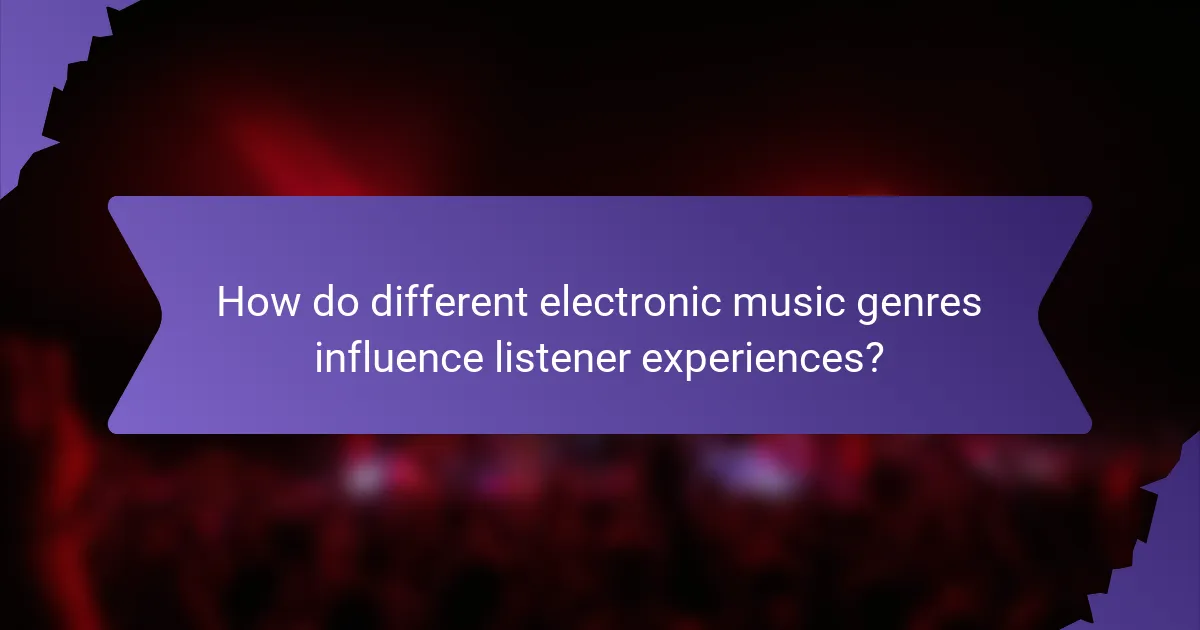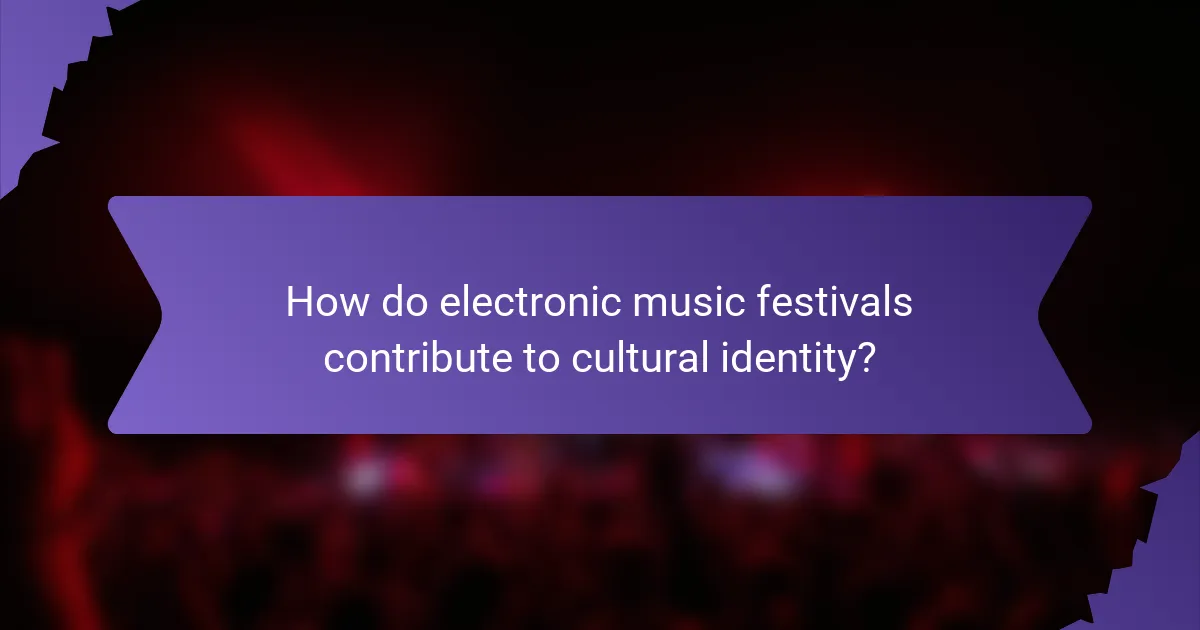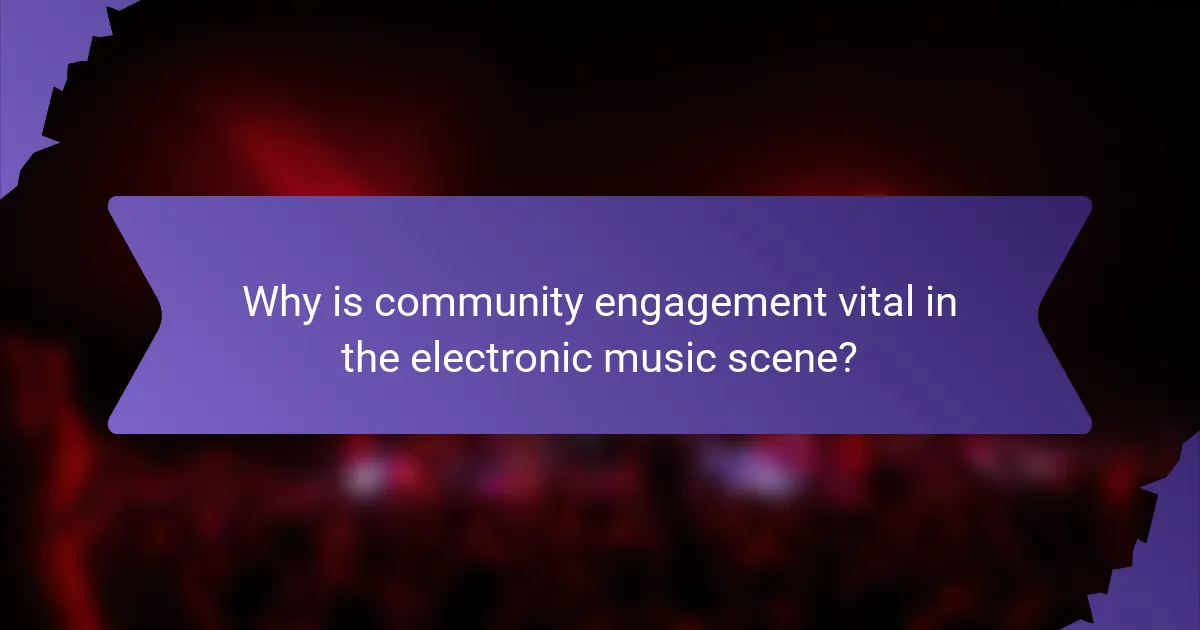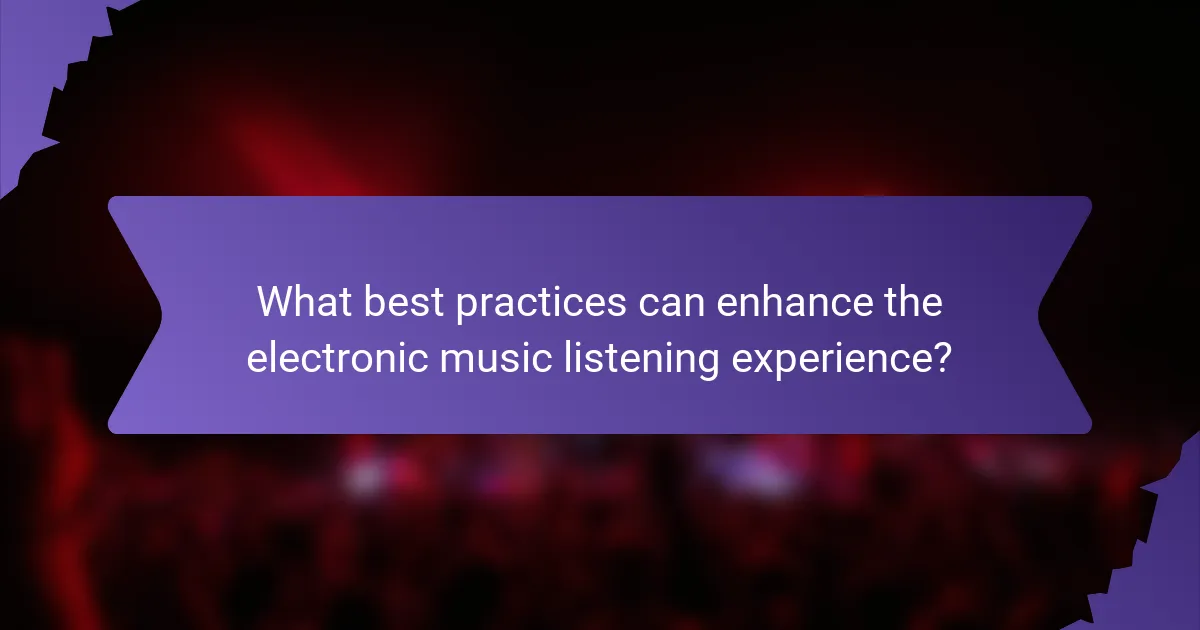Electronic music offers diverse genres that shape listener experiences and emotions. This article explores the impact of technological advances on music creation, the significance of festival culture in fostering community and diversity, and the challenges faced by artists in a competitive landscape. Discover how these elements intertwine to enhance the electronic music experience and cultural identity.

How do different electronic music genres influence listener experiences?
Different electronic music genres significantly shape listener experiences by evoking distinct emotions and atmospheres. For instance, techno often creates a hypnotic state, while house music fosters a sense of community. Genres like dubstep can elicit intense energy, contrasting with ambient music that promotes relaxation. Each genre’s unique attributes influence how listeners engage with the music, impacting mood and social interactions. Festivals amplify these effects, offering immersive environments that enhance genre-specific experiences.
What are the defining characteristics of popular electronic music genres?
Popular electronic music genres are characterized by unique rhythms, production techniques, and cultural influences. Genres like house, techno, and dubstep each have distinct tempo ranges and sound signatures. House music typically features a steady four-on-the-floor beat, while techno emphasizes repetitive beats and synthesized sounds. Dubstep is known for its heavy bass and syncopated rhythms. Additionally, genres evolve with technological advances, incorporating new software and hardware, which shapes their sound and accessibility. Festival culture plays a significant role, promoting community and live experiences that enhance genre appreciation.
How do regional preferences shape genre popularity in electronic music?
Regional preferences significantly influence genre popularity in electronic music. Cultural backgrounds, local trends, and available technology shape what resonates with audiences. For instance, techno thrives in European cities like Berlin, while trap gains traction in the United States. Festivals play a crucial role, showcasing local talent and fostering community engagement. Additionally, access to streaming platforms allows for the exploration of diverse genres, further impacting preferences. These dynamics create a unique landscape where electronic music evolves regionally, reflecting both global influences and local tastes.

What technological advances are shaping the future of electronic music?
Technological advances such as artificial intelligence, virtual reality, and advanced software tools are shaping the future of electronic music. AI algorithms create unique sounds and compositions, while virtual reality enhances immersive experiences for listeners. Additionally, digital audio workstations (DAWs) continue to evolve, offering new features that streamline music production. These innovations allow artists to experiment with genres and push creative boundaries.
How has software innovation transformed music production techniques?
Software innovation has significantly transformed music production techniques by enhancing accessibility, creativity, and efficiency. Digital audio workstations (DAWs) have replaced traditional recording methods, allowing producers to manipulate sound with precision.
The introduction of virtual instruments and plugins has expanded the sonic palette, enabling genres like electronic music to evolve rapidly. For instance, software synthesizers offer unique sound design capabilities that were previously unattainable.
Moreover, cloud-based collaboration tools facilitate remote teamwork, allowing artists from different locations to create music together seamlessly. As a result, festival culture has embraced diverse electronic genres, showcasing innovative sounds shaped by these technological advances.
In summary, software innovation has redefined music production, fostering creativity and collaboration while driving the evolution of electronic music genres.
Which hardware advancements are essential for modern electronic music artists?
Modern electronic music artists require advanced hardware such as powerful computers, MIDI controllers, audio interfaces, synthesizers, and drum machines. These tools enhance creativity and efficiency in music production.
Powerful computers enable seamless processing of complex audio tracks. MIDI controllers provide tactile control over software instruments, allowing for expressive performances. Audio interfaces improve sound quality and reduce latency, essential for professional recordings. Synthesizers offer unique sound design capabilities, while drum machines facilitate rhythmic programming.
Investing in high-quality hardware ensures artists can explore diverse genres and push creative boundaries in electronic music.
What role do streaming platforms play in the distribution of electronic music?
Streaming platforms significantly enhance the distribution of electronic music by providing global access and promoting diverse genres. They allow artists to reach wider audiences without traditional barriers. Platforms like Spotify and SoundCloud enable user engagement through playlists and recommendations, fostering community interaction. Additionally, data analytics from streaming services help artists understand listener preferences, shaping future releases. This democratization of music distribution empowers both established and emerging electronic artists, facilitating a vibrant festival culture that thrives on accessibility and innovation.

How do electronic music festivals contribute to cultural identity?
Electronic music festivals significantly enhance cultural identity by fostering community, promoting diversity, and encouraging artistic expression. These events create spaces where individuals from various backgrounds unite through shared musical experiences.
The festival culture also emphasizes inclusivity, allowing diverse genres to thrive and reflect different cultural influences. For instance, festivals often feature international artists, showcasing unique sounds that resonate with local and global audiences.
Moreover, electronic music festivals serve as platforms for emerging artists, enabling them to express their cultural narratives. This aspect strengthens the connection between music and identity, as attendees engage with performances that reflect their values and experiences.
In summary, electronic music festivals contribute to cultural identity by building community ties, promoting diverse artistic expressions, and providing platforms for cultural storytelling.
What are the key elements that define the festival experience for attendees?
The key elements that define the festival experience for attendees include music, atmosphere, community, and technology. Music genres shape the overall vibe, while immersive environments enhance emotional engagement. Community fosters connections among attendees, creating lasting memories. Technological advances, such as sound systems and visual effects, elevate the sensory experience.
How do festivals vary in structure and theme across different regions?
Festivals vary in structure and theme across regions, reflecting local culture and musical preferences. For example, European electronic music festivals often emphasize elaborate stage designs and visual experiences, while North American festivals may focus more on artist lineups and community engagement. In Asia, festivals might incorporate traditional elements, blending electronic music with local sounds. Each region’s unique attributes shape the festival experience, influencing everything from duration to audience interaction.
What impact do electronic music festivals have on local economies?
Electronic music festivals significantly boost local economies through increased tourism, job creation, and local business support. These events attract thousands of attendees, generating revenue for hotels, restaurants, and transportation services. For example, a single festival can inject millions into a local economy, enhancing the community’s financial health. Additionally, festivals often create temporary employment opportunities, further contributing to economic growth.

Why is community engagement vital in the electronic music scene?
Community engagement is vital in the electronic music scene because it fosters collaboration, creativity, and a sense of belonging. Active participation strengthens local scenes, enhances festival experiences, and promotes diverse musical expressions. Engaged communities drive innovation, allowing artists to experiment with genres and technology. As a result, festivals become platforms for cultural exchange, showcasing unique talents and building lasting connections.
How do online platforms foster collaboration among electronic music artists?
Online platforms enhance collaboration among electronic music artists by providing tools for sharing, networking, and co-creating. These platforms allow artists to connect globally, share their work, and collaborate on projects in real-time.
For example, platforms like SoundCloud and BandLab enable artists to upload tracks, receive feedback, and invite others to contribute. Additionally, social media networks facilitate the discovery of new talent and foster community engagement.
The rise of digital audio workstations (DAWs) with cloud capabilities has transformed collaboration, allowing multiple artists to work on a single project simultaneously, regardless of location. This technological advance has made it easier for artists to blend genres and experiment with new sounds.
Overall, online platforms play a crucial role in promoting innovation and creativity in the electronic music scene by breaking down geographical barriers and encouraging collaborative efforts.
What are the benefits of grassroots movements in promoting electronic music?
Grassroots movements significantly enhance electronic music by fostering community engagement, promoting diverse genres, and supporting local artists. These movements create platforms for emerging talent, allowing for innovative sounds to thrive. They often lead to unique festival experiences that celebrate local culture while attracting wider audiences. As a result, grassroots initiatives contribute to the sustainability and evolution of the electronic music scene.

What challenges do electronic music artists face in the industry?
Electronic music artists face significant challenges, including market saturation, evolving technology, and competition for live performance opportunities.
The electronic music industry is highly competitive, with numerous artists vying for attention. This saturation makes it difficult for new artists to stand out. Additionally, technological advances require artists to continually adapt to new tools and software, which can be both a challenge and an opportunity.
Another challenge is the reliance on live performances for income. As festival culture grows, securing slots at major events becomes increasingly competitive. Artists must not only produce quality music but also build a strong brand presence to attract audiences and promoters.
Lastly, navigating the complexities of digital distribution and streaming platforms poses challenges. Artists often struggle with fair compensation and visibility in an oversaturated market.
How do copyright issues affect electronic music production and distribution?
Copyright issues significantly impact electronic music production and distribution by restricting the use of samples and compositions. Producers must navigate licensing agreements to avoid legal repercussions. Unauthorized use can lead to financial penalties and loss of distribution rights. Additionally, copyright laws vary globally, complicating international distribution. Understanding these regulations is essential for successful electronic music careers.
What strategies can artists use to navigate the competitive landscape?
Artists can navigate the competitive electronic music landscape by leveraging unique branding, networking, and continuous skill development. Establishing a distinct sound helps in creating a recognizable identity. Collaborating with other artists and engaging with fans at festivals enhances visibility and builds a supportive community. Additionally, staying updated on technological advances allows artists to innovate and experiment with their music. Regularly participating in online platforms for sharing and promoting their work can expand their reach and audience engagement.

What best practices can enhance the electronic music listening experience?
To enhance the electronic music listening experience, focus on high-quality sound systems and immersive environments. Quality headphones or speakers significantly impact audio clarity. Explore spatial audio technology for a more engaging experience. Attend live events or festivals to enjoy the communal atmosphere and unique performances. Engage with online communities to discover new genres and artists, enriching your musical journey.
How can fans support their favorite electronic music artists effectively?
Fans can support their favorite electronic music artists effectively by engaging with their music, attending live events, and promoting their work on social media. Listening to their tracks on streaming platforms boosts their visibility and revenue. Attending festivals and shows fosters a direct connection with artists while providing financial support through ticket sales. Sharing artist content on social media amplifies their reach and connects them with new fans. Additionally, purchasing merchandise directly from artists helps sustain their careers. Engaging in these activities strengthens the electronic music community and enhances the festival culture.
What are common mistakes to avoid when attending electronic music festivals?
To enhance your experience at electronic music festivals, avoid these common mistakes.
First, neglecting hydration can lead to fatigue and health issues. Always carry water to stay energized. Second, skipping ear protection is a mistake; loud music can cause hearing damage. Invest in quality earplugs. Third, failing to plan your schedule may lead to missing favorite acts. Review the lineup and set times in advance. Fourth, dressing inappropriately for weather conditions can ruin your experience; check forecasts and dress accordingly. Lastly, overpacking can weigh you down; bring only essentials for comfort and convenience.
Which tips can help new artists establish a presence in the electronic music scene?
New artists can establish a presence in the electronic music scene by leveraging social media, collaborating with established artists, and performing at local events. Building an online portfolio showcasing original tracks and remixes is essential. Networking at festivals and engaging with fans can also enhance visibility. Utilizing platforms like SoundCloud and Bandcamp helps distribute music effectively. Consistency in releases and maintaining a unique sound are crucial for long-term success.